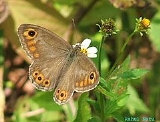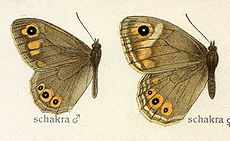
Lasiommata schakra
Encyclopedia
The Common Wall, Lasiommata schakra, is a species of satyrine
butterfly
found in South Asia
.


 Shows slight sexual dimorphism. Male upperside ground colour silky brown; cilia of both wings whitish. Forewing has a transverse row of four large orange spots, the apical one the largest, bearing a black, white-centered eyespot; beyond the row of orange spots a sub-terminal dark brown line. Hind wing uniform, but bearing a postdiscal row of from three to six black, white-centered, orange-ringed eyespot. Underside very pale greyish white; fore wing: disc orange, outwardly defined by a dark line, two lines across the discoidal cell, and a sinuous discal oblique line beyond its apex not extending to the tornus, orange-brown ; subterminal and terminal dark lines; a subapical eyespot, as on the upperside, but with the outer ring paler, and a much smaller ocellus beyond it towards apex of wing. Hind wing has the basal half crossed by two sinuous curved slender lines, a shorter line crossing the cell only, and another short line defining the discocellular veins, orange-brown; the curved row of ocelli as on the upperside, but each ocellus with rings of pale ochraceous and of brown, alternately two of each; lastly, a sub-terminal and a terminal brown line. Antennae brown; head and thorax studded with long dark grey pubescence; abdomen pale brown. Sex-mark present.
Shows slight sexual dimorphism. Male upperside ground colour silky brown; cilia of both wings whitish. Forewing has a transverse row of four large orange spots, the apical one the largest, bearing a black, white-centered eyespot; beyond the row of orange spots a sub-terminal dark brown line. Hind wing uniform, but bearing a postdiscal row of from three to six black, white-centered, orange-ringed eyespot. Underside very pale greyish white; fore wing: disc orange, outwardly defined by a dark line, two lines across the discoidal cell, and a sinuous discal oblique line beyond its apex not extending to the tornus, orange-brown ; subterminal and terminal dark lines; a subapical eyespot, as on the upperside, but with the outer ring paler, and a much smaller ocellus beyond it towards apex of wing. Hind wing has the basal half crossed by two sinuous curved slender lines, a shorter line crossing the cell only, and another short line defining the discocellular veins, orange-brown; the curved row of ocelli as on the upperside, but each ocellus with rings of pale ochraceous and of brown, alternately two of each; lastly, a sub-terminal and a terminal brown line. Antennae brown; head and thorax studded with long dark grey pubescence; abdomen pale brown. Sex-mark present.
Female is similar but on the upperside, the orange spot bearing the ocellus on the fore wing inwardly bordered by a broad, pale, short line; the raised band of specialized scales absent.
Wing expanse of 56-58 mm.
Satyrinae
Satyrinae, the satyrines or satyrids, commonly known as the Browns, is a subfamily of the Nymphalidae . They were formerly considered a distinct family, Satyridae. This group contains nearly half of the known diversity of brush-footed butterflies...
butterfly
Butterfly
A butterfly is a mainly day-flying insect of the order Lepidoptera, which includes the butterflies and moths. Like other holometabolous insects, the butterfly's life cycle consists of four parts: egg, larva, pupa and adult. Most species are diurnal. Butterflies have large, often brightly coloured...
found in South Asia
South Asia
South Asia, also known as Southern Asia, is the southern region of the Asian continent, which comprises the sub-Himalayan countries and, for some authorities , also includes the adjoining countries to the west and the east...
.


Description
- See glossaryGlossary of Lepidopteran termsThis glossary describes the terms used in the formal descriptions of insect species, jargon used mostly by professionals or entomologist....
for terms used

Female is similar but on the upperside, the orange spot bearing the ocellus on the fore wing inwardly bordered by a broad, pale, short line; the raised band of specialized scales absent.
Wing expanse of 56-58 mm.

